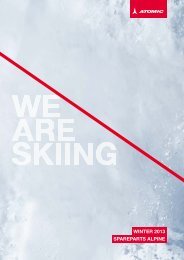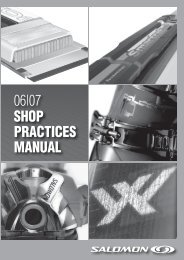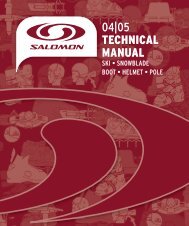SPM 05 ENvFIN.indd - Salomon Certification
SPM 05 ENvFIN.indd - Salomon Certification
SPM 05 ENvFIN.indd - Salomon Certification
You also want an ePaper? Increase the reach of your titles
YUMPU automatically turns print PDFs into web optimized ePapers that Google loves.
The Boot<br />
• Inconsistencies with ISO and<br />
applicable norms.<br />
• Gross irregularities where<br />
the boot contacts the<br />
binding and the AFD.<br />
• Unacceptable low grade<br />
thermoplastic construction.<br />
• Rubber and/or metal tip<br />
protectors<br />
• Mold flashings.<br />
• Excessive wear.<br />
• Debris lodged in the sole.<br />
• Warped or improperly<br />
canted boot sole.<br />
• Cut-outs in the sole that<br />
impede proper brake<br />
function. (If you are<br />
uncertain of boot compatibility,<br />
perform the Clean vs.<br />
Lubricated Test. Boots that<br />
fail this test or violate any of<br />
the above points should not<br />
be used with any <strong>Salomon</strong><br />
binding.)<br />
A<br />
S<br />
Visual Inspection of System Components<br />
Common Compatibility Problems<br />
Test for Elastic Travel & Return<br />
Procedure<br />
The Ski<br />
• Mounting screws protruding<br />
through the base.<br />
• Delaminated sidewall. This<br />
can be detected visually or<br />
by running your fingers<br />
along the sides of the ski.<br />
• Binding baseplates not flush<br />
with ski surface.<br />
• Delaminated topskin.<br />
• Pre-drilled holes. As a<br />
general rule, bindings should<br />
not be installed on skis that<br />
have previously been drilled<br />
for three or more sets of<br />
bindings.<br />
The Binding<br />
Components<br />
• Stripped, loose or<br />
missing screws.<br />
• Condition of the AFD<br />
(ripped, loose, imbedded<br />
dirt, boot sole pattern, tread<br />
Lateral.<br />
Secure the ski. Hit the<br />
forefoot area of the boot<br />
with an object that will not<br />
damage the boot, such as a<br />
rubber hammer. Fig A Use<br />
sufficient force to move<br />
Vertical.<br />
Depress the heel lever<br />
while pulling forward on the<br />
upper cuff of the boot until<br />
the boot heel lifts at least<br />
5 mm. Fig S Release both<br />
hands simultaneously. The<br />
boot should return to the ski<br />
quickly and smoothly. This<br />
Test for Boot/Binding Compatibility<br />
Procedure<br />
Check the boot/binding<br />
combination to ensure all<br />
components are compatible.<br />
Unless a binding is specifically<br />
designed for use with<br />
both junior and adult norm<br />
boot soles, adult and junior<br />
systems cannot be combined,<br />
e.g., junior boots with adult<br />
bindings or vice versa. If<br />
imprint, etc.).<br />
• Condition of anti-friction<br />
inserts (where applicable).<br />
• Missing or unreadable visual<br />
indicators and missing<br />
windows.<br />
• Bent or broken baseplate,<br />
principal axis or housing.<br />
• Stripped or jammed toe<br />
height and cup adjustment<br />
screws.<br />
• Jammed release adjustment<br />
screw.<br />
• Other visible wear.<br />
• Improperly installed leash<br />
or brake.<br />
• Irregular heel track function.<br />
• Bent or broken baseplate,<br />
track or heel.<br />
The Ski Brake<br />
• Improper brake arm length.<br />
• Improper installation.<br />
• Broken entry pedals.<br />
the boot off-center, but not<br />
hard enough to release the<br />
system. The boot should<br />
move off-center at least<br />
inspection can be performed<br />
either manually or by using<br />
a mechanical testing device.<br />
If a testing device is used,<br />
follow the recommendations<br />
of the test device manufacturer<br />
for proper procedure.<br />
If the system passes these<br />
tests, mark “Pass” (√) on<br />
the system passes this test,<br />
mark “Pass” (√) on the<br />
Workshop Form for “Test of<br />
Boot-Binding Compatibility.”<br />
If you are not sure that<br />
FINAL CHECKING<br />
FINAL CHECKING<br />
& System Inspection<br />
• Bent or broken brake arms.<br />
• Strength of ski brake. A<br />
brake must not compress<br />
totally when the ski is set on<br />
a flat surface.<br />
• Other visible wear.<br />
The Complete System<br />
Place the boot in the binding<br />
and check the accuracy of:<br />
• Toe height adjustment<br />
(if applicable).<br />
• Toe cup width adjustment (if<br />
applicable).<br />
• Central roller adjustment<br />
(if applicable).<br />
• Forward pressure<br />
adjustment.<br />
• Visual indicator settings.<br />
• Symmetrical mounting of<br />
bindings to ski center line<br />
(1 mm). This should be in<br />
the same location on both<br />
skis.<br />
5 mm and return to center<br />
within 2 mm of its original<br />
position.<br />
the Workshop Form for<br />
“Test for Elastic Travel &<br />
Return”. If the system fails,<br />
see Troubleshooting.<br />
the boot complies with<br />
standards or if you are<br />
not sure that the system<br />
components are compatible,<br />
see Troubleshooting.<br />
> Reference<br />
<strong>Salomon</strong><br />
Workshop Form<br />
Troubleshooting<br />
Standard Boot<br />
Sole Dimensions<br />
27<br />
32<br />
29<br />
8








